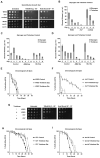Mitochondrial respiratory thresholds regulate yeast chronological life span and its extension by caloric restriction
- PMID: 22768839
- PMCID: PMC3397320
- DOI: 10.1016/j.cmet.2012.05.013
Mitochondrial respiratory thresholds regulate yeast chronological life span and its extension by caloric restriction
Abstract
We have explored the role of mitochondrial function in aging by genetically and pharmacologically modifying yeast cellular respiration production during the exponential and/or stationary growth phases and determining how this affects chronological life span (CLS). Our results demonstrate that respiration is essential during both growth phases for standard CLS, but that yeast have a large respiratory capacity, and only deficiencies below a threshold (~40% of wild-type) significantly curtail CLS. Extension of CLS by caloric restriction also required respiration above a similar threshold during exponential growth and completely alleviated the need for respiration in the stationary phase. Finally, we show that supplementation of media with 1% trehalose, a storage carbohydrate, restores wild-type CLS to respiratory-null cells. We conclude that mitochondrial respiratory thresholds regulate yeast CLS and its extension by caloric restriction by increasing stress resistance, an important component of which is the optimal accumulation and mobilization of nutrient stores.
Copyright © 2012 Elsevier Inc. All rights reserved.
Figures







References
-
- Aerts AM, Zabrocki P, Govaert G, Mathys J, Carmona-Gutierrez D, Madeo F, Winderickx J, Cammue BP, Thevissen K. Mitochondrial dysfunction leads to reduced chronological lifespan and increased apoptosis in yeast. FEBS Lett. 2009;583:113–117. - PubMed
-
- Barros MH, Bandy B, Tahara EB, Kowaltowski AJ. Higher respiratory activity decreases mitochondrial reactive oxygen release and increases life span in Saccharomyces cerevisiae. J. Biol. Chem. 2004;279:49883–49888. - PubMed
Publication types
MeSH terms
Substances
Grants and funding
LinkOut - more resources
Full Text Sources
Other Literature Sources
Molecular Biology Databases

